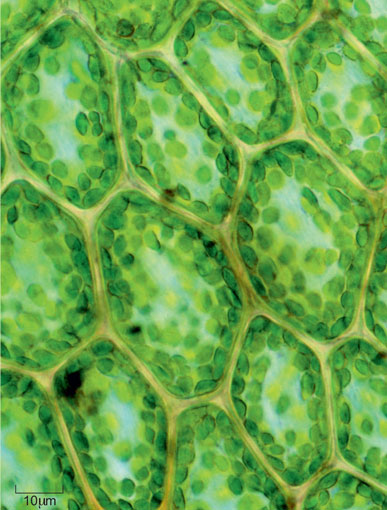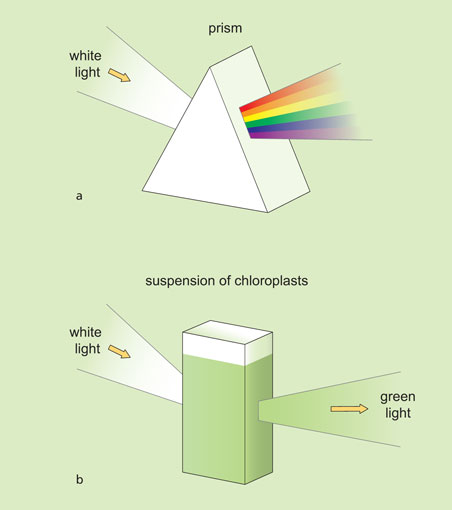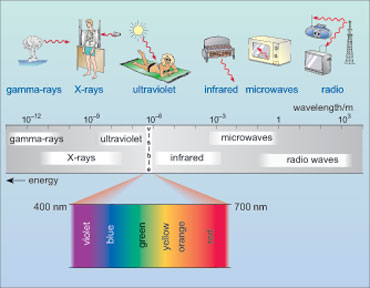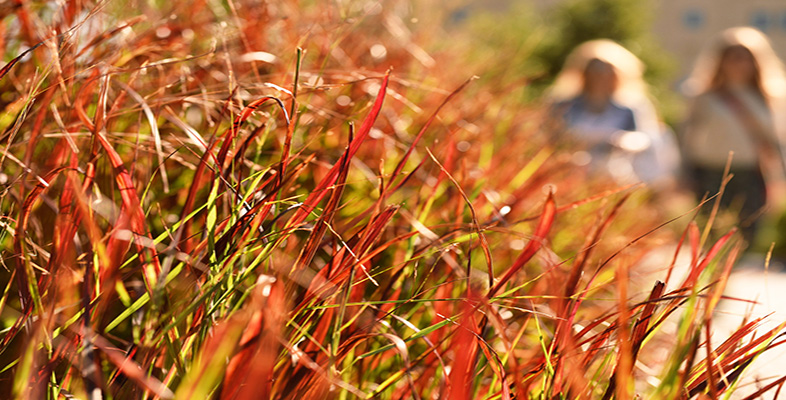2.1 Photosynthesis
Box 1 Photosynthesis in plants
Photosynthesis is a complex process that involves the plant using energy from sunlight to combine carbon dioxide gas with water to make sugar. The reaction can be expressed in words as follows:
water + carbon dioxide → sugar + oxygen
The sugar is typically in the form of glucose, but it could be other kinds of sugar, or indeed sugar alcohols. The oxygen that is a by-product of the reaction is essential for all plant and animal life. Photosynthesis occurs inside chloroplasts, which are found in the leaves (and other green parts) of the plant. Chloroplasts contain molecules of chlorophyll, a green pigment that captures energy from sunlight and harnesses it to enable the sugar to be produced. Chemically, plant tissue is mostly made up of compounds containing carbon (known as organic compounds), which are made by a very complex set of chemical reactions from the sugar produced during photosynthesis. Around 44% of the dry weight (that is, weight excluding water) of a living plant is carbon, captured from the air during photosynthesis.

Why are plants green?
An isolated extract of chlorophyll is dark green in colour. Sunlight (white light) comprises all the colours of the rainbow. Chlorophyll absorbs much of the blue and red light that falls on it, but most of the green light is reflected and so can be detected by our eyes. This is why chlorophyll itself and the vast majority of plant leaves appear green. Interestingly, if the photosynthetic pigments absorbed all the colours of light the leaves would appear black and, as black surfaces absorb heat particularly efficiently, plants would probably overheat.

Question 7
On the basis of what you have read so far, summarise the process of photosynthesis in your own words in one or two sentences.
Answer
Photosynthesis is the process by which plants {and also algae and some bacteria} are able to use light energy (from the Sun) to convert carbon dioxide into sugar (carbohydrate) which can then be stored as starch in the plant. The reactions take place within the green parts of the plant, mainly the leaves, which use cells containing chloroplasts.
Plants contain special chemicals called photosynthetic pigments that allow the plant to harvest the light energy.
Question 8
Which of these pigments have you already met?
Answer
Chlorophyll, the green pigment in chloroplasts.
Only a small proportion, around 5%, of the light that falls on a leaf is actually used for photosynthesis. To understand why, Box 2 briefly explains the nature of light.
Box 2 The electromagnetic spectrum
Visible light is composed of a spectrum of colours, as in a rainbow. It is one form of electromagnetic radiation, which is defined as energy in the form of waves that have both electrical and magnetic properties. The electromagnetic spectrum is defined as a series of different forms of radiation which have different wavelengths. Figure 5 illustrates the range of the electromagnetic spectrum and the some of the different ways in which the different forms of radiation within the spectrum have been used. You can see that the range for visible light used for photosynthesis is only a very small part of the overall spectrum.

In Figure 5, the value of the wavelength of the electromagnetic radiation is between about 10-12 m and 103 m (that is between 0.000 000 000 001 and 1000 metres).
Question 9
From Figure 5, how does the energy of the radiation vary with its wavelength?
Answer
The radiation with the shortest wavelength has the highest energy. Gamma-rays (wavelength 10-12 m) are very high energy while radio waves (wavelength 1-103 m) are very low energy.
Question 10
Using the information in Figure 5 arrange the following colours of visible light in order of increasing energy: violet, red, orange and green.
Answer
The colour with the lowest energy is red, then orange, then green and finally violet.
Question 11
From Figure 4, which colour of visible light is not absorbed by plants?
Answer
Green light is not absorbed but is reflected, which, as you may remember, is the reason that we can see it and why plants look green.
Question 12
If you have a blue flower, which wavelengths of light are absorbed and which are reflected?
Answer
In order to appear blue, blue light must be reflected and not absorbed - and the other colours of the spectrum including orange, yellow, green and red must be absorbed
The photosynthetic pigments in plants absorb best in certain areas of the electromagnetic spectrum - generally speaking those areas corresponding to visible light and, in particular, the blue and red portions of the visible spectrum.
